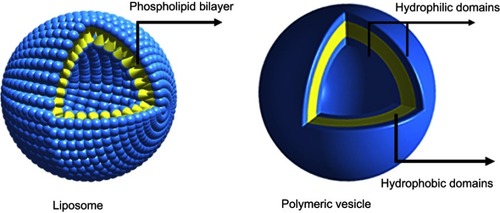Figures & data
Figure 2 Illustration of pH-sensitive degradable polymersomes based on PEG-PTMBPEC diblock copolymer for triggered release of both hydrophilic and hydrophobic anticancer drugs. In comparison, pH-sensitive degradable micelles are typically applied for release of hydrophobic drugs only. Reprinted from Chen W, Meng F, Cheng R, Zhong Z. pH-Sensitive degradable polymersomes for triggered release of anticancer drugs: a comparative study with micelles. J Control Release. 2010;142(1):40–46. Copyright 2009, with permission from Elsevier.Citation21
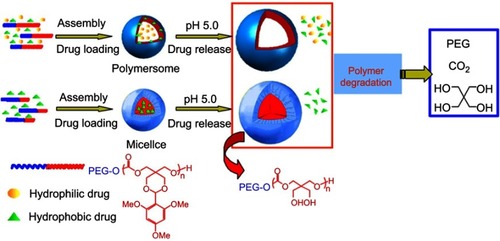
Figure 3 Cartoon representation of NDTH polymersomes and the release process of pH-responsive nanovesicles encapsulated DOX. stimulus-responsive. Reprinted with permission from Mane SR, Rao NV, Chaterjee K, Dinda H, Nag S, Kishore A, Das Sarma J, Shunmugam R. Amphiphilic Homopolymer Vesicles as Unique Nano-Carriers for Cancer Therapy. Macromolecules. 2012;45(19):8037–8042. Copyright 2012, American Chemical Society.Citation27
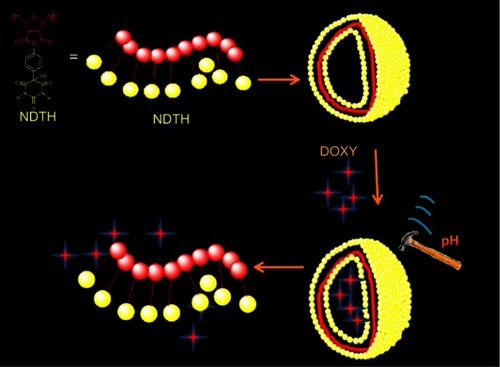
Figure 4 Self-assembly (SA) of the copolymer and the thermally induced drug release of resulting micelles in aqueous solution. Reprinted from Cao X, Chen Y, Chai W, Zhang W, Wang Y, Fu PF. Thermoresponsive self-assembled nanovesicles based on amphiphilic triblock copolymers and their potential applications as smart drug release carriers. Journal of Applied Polymer Science. 2015;132(4):41361–41372. Copyright 2014, with permission from John Wiley and Sons.Citation51

Figure 5 PVCLn-b-PVPONm diblock copolymers (A) assembled into polymersomal nanocapsules at T>LCST (B) can be locked with TA (C) via hydrogen bonds with PVPON, which results in PVCLn-PVPONm nanocapsules stable at T<LCST (D). Reprinted with permission from Kozlovskaya V, Liu F, Xue B, Ahmad F, Alford A, Saeed M Kharlampieva E. Polyphenolic Polymersomes of Temperature-Sensitive Poly(N-vinylcaprolactam)-block-Poly(N-vinylpyrrolidone) for Anticancer Therapy. Biomacromolecules. 2017;18(8):2552–2563. Copyright 2017, American Chemical Society.Citation61

Figure 6 Design of BCP vesicles exhibiting concurrent phototriggered “traceless” crosslinking and vesicle membrane permeabilization. PEO-b-PNBOC amphiphilic BCPs self-assemble into polymersomes with the hydrophobic bilayer containing carbamate-caged primary amine moieties. UV irradiation triggers decaging reactions and the release of primary amine functionalities, prominent amidation reaction then occurs because of a suppressed amine pKa within the hydrophobic vesicle membrane, resulting in vesicle crosslinking instead of vesicle-to-unimer disassembly. 1) Enhanced amidation within the hydrophobic microenvironment. 2) Unreactive primary amines because of protonation. Reprinted from Wang X, Liu G, Hu J, Zhang G, Liu S. Concurrent block copolymer polymersome stabilization and bilayer permeabilization by stimuli-regulated “traceless” crosslinking. Angew Chem Int Ed Engl. 2014;53(12):3138–3142. Copyright 2014, with permission from John Wiley and Sons.Citation68

Figure 7 (A) Schematic illustration of redox-responsive polymeric vesicles for overcoming the multidrug resistance of cancer cells and (B) Schematic outline of the predicted self-assembly behavior of PzLL-SSPEG-SS-PzLL triblock copolymers and their drug-release behavior. Reprinted with permission from Ren T, Wu W, Jia M, Dong H, Li Y, Ou Z. Reduction-cleavable polymeric vesicles with efficient glutathione-mediated drug release behavior for reversing drug resistance. ACS Appl Mater Interfaces. 2013;5(21):10,721–10,730. Copyright 2013, American Chemical Society.Citation73
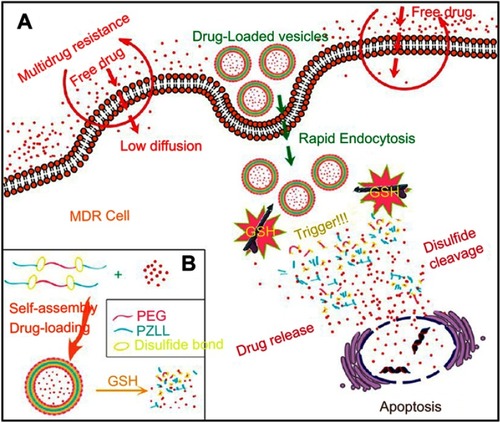
Figure 8 Structure of PS-β-CD and PEO-Fc and schematic of the voltage-responsive controlled assembly and disassembly of PS-β-CD/PEO-Fc supramolecular vesicles. Reprinted with permission from Yan Q, Yuan J, Cai Z, Xin Y, Kang Y, Yin Y. Voltage-Responsive Vesicles Based on Orthogonal Assembly of Two Homopolymers. J Am Chem Soc. 2010;132(27):9268–9270. Copyright 2010, American Chemical Society.Citation74
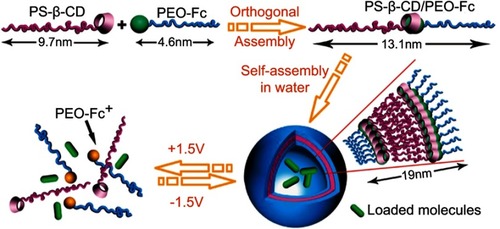
Figure 9 (A) Gas-switchable structural change of amidine-containing diblock copolymer PEO-b-PAD (top) and schematic representation of its self-assembly into vesicles and their reversible gas-responsive “breathing” in aqueous media (bottom). (B) Gas-switchable chemical structural change of the PEG-b-PAD block copolymer. The self-assembly of the copolymer into polymersomes and reversible gas-controlled breathing behavior in aqueous media. Reprinted from Yan Q, Zhou R, Fu C, Zhang H, Yin Y, Yuan J. CO2-responsive polymeric vesicles that breathe. Angew Chem Int Ed Engl. 2011:50(21):4923–4927. Copyright 2011, with permission from John Wiley and Sons.Citation79 Reprinted from Yan Q, Wang J, Yin Y, Yuan J. Breathing polymersomes: CO2-tuning membrane permeability for size-selective release, separation, and reaction. Angew Chem Int Ed Engl. 2013;52(19):5070–5073. Copyright 2013, with permission from John Wiley and Sons.Citation80

Figure 10 Self-assembling process of poly(nPA0.8-co-DEAEMA0.2)-block-poly(nPA0.8-co-EA0.2) into vesicles, and then aggregates upon heating. Reprinted with permission from Savoji MT, Strandman S, Zhu XX. Switchable vesicles formed by diblock random copolymers with tunable pH- and thermo-responsiveness. Langmuir. 2013;29(23):6823–6832. Copyright 2013, American Chemical Society.Citation84
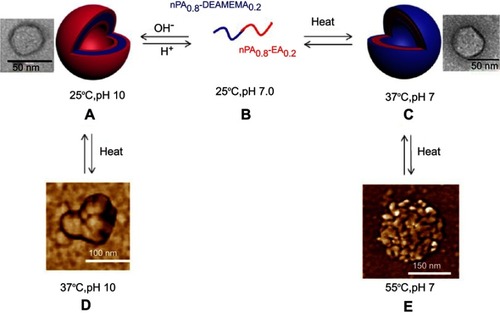
Figure 11 (A) Schematic overview of the DOX-encapsulated PS1C and PS1D formation. In vitro release of doxorubicin from PS1C-DOX polymersomes.(B) PS1D-DOX polymersomes (C) at 37 °C in different pH media. Reprinted with permission from Iyisan B, Kluge J, Formanek P, Voit B, Appelhans D. Multifunctional and Dual-Responsive Polymersomes as Robust Nanocontainers: Design, Formation by Sequential Post-Conjugations, and pH-Controlled Drug Release. Chemistry of Materials. 2016;28(5):1513–1525. Copyright 2016, American Chemical Society.Citation87
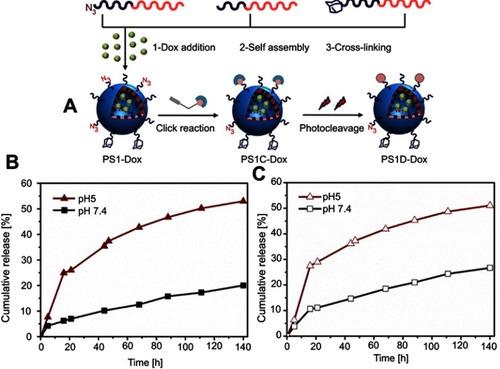
Figure 12 Illustration for synthesis and self-assembly of the supramolecular triblock copolymer PNIPAM-b-PCL-b-PDMAEMA, as well as their CO2−temperature dual stimulus-responsive process. Reprinted with permission from Liu B, Zhou H, Zhou S, et al. Synthesis and Self-Assembly of CO2–Temperature Dual Stimulus-responsive Triblock Copolymers. Macromolecules. 2014;47(9):2938–2946. Copyright 2014, American Chemical Society.Citation92
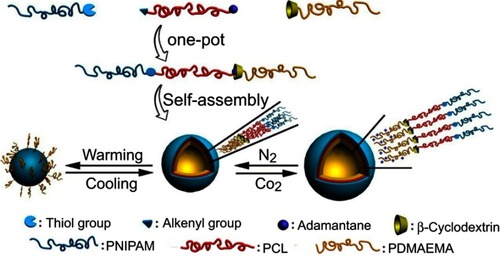
Figure 13 Schematic description for the multiresponsive transformation of the polypeptidosome in an aqueous solution. Reprinted from Liu G, Zhou L, Guan Y, Su Y, Dong CM. Multi-responsive polypeptidosome: characterization, morphology transformation, and triggered drug delivery. Macromol Rapid Commun. 2014;35(19):1673–1678. Copyright 2014, with permission from John Wiley and Sons.Citation96
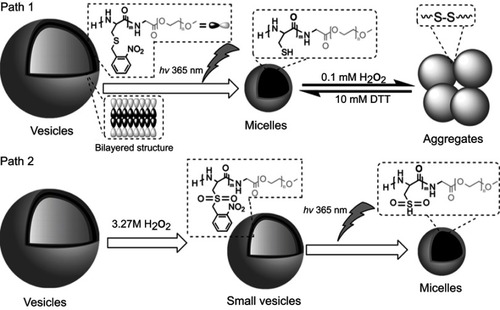
Figure 14 Illustration of the stable and tumor-targeting multifunctional wormlike polymer vesicles formed by triblock copolymers for targeted cancer chemotherapy and imaging. Reprinted from Biomaterials, 31(43), Yang X, Grailer JJ, Rowland IJ, et al, Multifunctional SPIO/DOX-loaded wormlike polymer vesicles for cancer therapy and MR imaging, 9065–9073, Copyright 2010, with permission from Elsevier.Citation108


